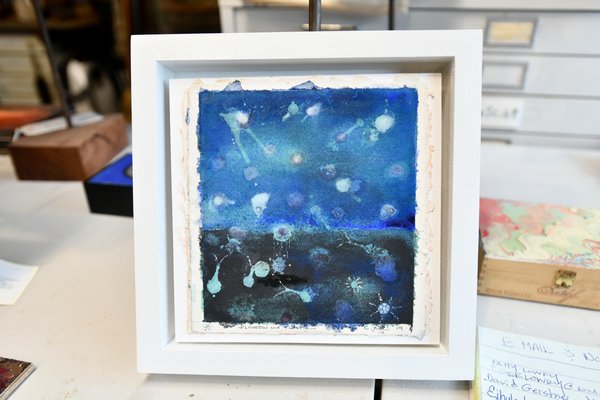
Another person’s trash is artist Cynthia Pease Roe’s treasure.
Her Southold studio, located at the boatyard at Port of Egypt Marine, is filled with containers of discarded lighters, balloons, straws, fishing tags and anything else that appears to no longer serve any purpose. Most of the items were found in beach cleanups on Long Island.
For Ms. Roe, the garbage can be used to make sculptures of anything from mermaids to manta rays. Through her organization, UpSculpt, she has been dedicated to raising awareness about marine debris through art for over 10 years.
Little did the person who discarded their soda bottle long ago realize that their trash would be used in one of Ms. Roe’s many sculptures which will be displayed at the Sag Harbor Whaling Museum as part of “Plankton Not Plastic,” an exhibition that opens on Friday, July 26.
The idea of turning garbage into art all started when Ms. Roe, who is also a painter, came across an abundance of plastic debris on the North Fork. She said that the experience changed the course of her work and her life. Before that, she had never put much effort into sculpting before.
“I think some people would be shocked to find out that what they threw out actually ended up in the ocean,” Ms. Roe said. “That’s pretty shocking. And then it ended up on a beach in Long Island some place.”
Garbage and litter, according to Ms. Roe, can travel up to 100 miles, and on Long Island, which is just 23 miles at its widest, there’s a good chance it will end up in the ocean, sound or bay.
“We are an island,” Ms. Roe said. “Anything that’s falling out of your car, any of this litter or garbage around here, has the ability to make its way into the ocean. We have to wake up.”
Plastic that ends up in the ocean can break down into small particles called microplastics, which can then be ingested by zooplankton, a tiny animal vital to marine life as it is the basis of most marine food webs.
“These microplastics become toxins in an ocean environment,” Ms. Roe said. “This becomes part of a big, big food chain. Those little microplastics becomes compounded when you start talking about a tuna fish, swordfish, larger fish that we’re eating. It’s also being ingested by sea mammals.”
The exhibition at the Whaling Museum will feature sculptures by Ms. Roe, including a mermaid, manta rays and whales sculptures. There will also be paintings and high definition videos from an underwater ROV, or remotely operated vehicle, dives by the California-based Schmidt Ocean Institute.
With this show, Ms. Roe is hoping that people will observe the “beauty of the ocean, the importance of the ocean, understanding that there are all forms of life in the ocean and that it starts with plankton and zooplankton.”
There will also be workshops available for kids ages 8 and up, held by Ms. Roe and local environmental educator Rachel Gruzen, who taught science part-time at the Ross School. The two-hour workshops will teach participants about ocean ecosystems, plastic pollution, ways of reducing marine debris and how to use found materials to make artistic creations.
This wasn’t the first time Ms. Roe has raised awareness about marine debris at the Sag Harbor Whaling Museum. In 2017, she presented an exhibition titled “Beauty and the Beast.” The “beauty” in the show was the ocean. The “beast” was plastic marine litter.
Earlier this year, Ms. Roe reached out to the museum again to lobby for another exhibit.
“They seemed to be open to doing [the exhibit] and felt that it would be a good fit for launching their marine conservation program that they are building right now,” she said.
The new Marine Conservation Center for Children and Young Adults at the Sag Harbor Whaling Museum, according to a recent press release, will focus on educational programs related to the health of the bays and oceans, sustainable use of marine resources, past and present maritime culture and economies, maritime art and culture, and good maritime citizenship.
“We’re trying to celebrate Sag Harbor and its maritime culture and history via the museum collection and inspirational interactions with local artists, conservationists and maritime industry professionals,” Ms. Gruzen said, “and it obviously pairs with raising awareness for marine conservation challenges.”
Ms. Roe acknowledges that we’ve all been raised in the plastic society, but she adds that everyone needs to pay attention now.
“Right now we have the opportunity to turn the tide,” Ms. Roe said. “If the amount of plastic, which is nine million metric tons going into the ocean every year, keeps continuing at the rate it is, then the ocean will collapse. And if the ocean collapses, the world collapses. Because we need the ocean to survive.”
“We do need to wake up.”
“Plankton Not Plastic,” opens Friday, July 26, with a reception from 6 to 8 p.m., and runs through Sunday, August 4 at the Sag Harbor Whaling Museum, 200 Main Street, Sag Harbor. Cost for the children’s workshops, which are on July 28 and August 4, is $25 for the first child and $10 for additional children in the same family. More information is available at sagharborwhalingmuseum.org or (631) 725-1700. More information about Cindy Pease Roe and UpSculpt can be found at upsculpt.com.